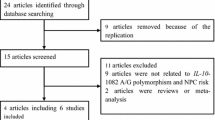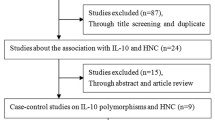Abstract
Aim
To evaluate the possible relevance of the IL-18-137 G>C (rs187238), IL-18-607 C>A (rs1946518) and IL-4-590 C>T (rs2243250) polymorphisms to the genetic susceptibility of head and neck cancer.
Methods
Data were retrieved from PubMed, EMBASE, Web of Science and CNKI databases, and the results were independently analysed by two reviewers using Stata 14.0 software.
Results
After searching for and assessing the literature, a total of thirteen studies involving 2,959 patients newly diagnosed as head and neck cancer and 3,622 controls from healthy donors were analysed. The results suggested that a strong relationship between patients and healthy controls was observed in the IL-18-137 G>C polymorphism in consistence with the result (CC vs. GG + GC: OR = 1.63, P = 0.004; CC vs. GG: OR = 1.82, P = 0.001). When stratified by cancer type, ethnicity and the source of control samples, significant and elevated risks were obtained in the genetic susceptibility to Asian patients with NPC in all genetic models and in those studies using the PCR-RFLP test method. In addition, comparable results were obtained for the IL-18-607 C>A polymorphism, especially for Asian patients with NPC.
Conclusions
It should be a potential association between IL-18 variants and nasopharyngeal carcinoma. Furthermore, IL-18 gene variants might be considered as a critical role in predicting the occurrence of nasopharyngeal carcinoma in Asian population. However, the IL-4-590 C>T polymorphism does not influence the development of head and neck cancer.







Similar content being viewed by others

References
Argiris A, Karamouzis MV, Raben D, Ferris RL (2008) Head and neck cancer. Lancet 371:1695–1709
Warnakulasuriya S (2009) Global epidemiology of oral and oropharyngeal cancer. Oral Oncol 45:309–316
Ferlay J, Soerjomataram I, Dikshit R, Eser S, Mathers C, Rebelo M et al (2015) Cancer incidence and mortality worldwide: sources, methods and major patterns in GLOBOCAN 2012. Int J Cancer 136:E359–E386
Torre LA, Bray F, Siegel RL, Ferlay J, Lortet-Tieulent J, Jemal A (2015) Global cancer statistics, 2012. CA Cancer J Clin 65:87–108
Pai SI, Westra WH (2009) Molecular pathology of head and neck cancer: implications for diagnosis, prognosis, and treatment. Annu Rev Pathol 4:49–70
Saba NF, Goodman M, Ward K, Flowers C, Ramalingam S, Owonikoko T et al (2011) Gender and ethnic disparities in incidence and survival of squamous cell carcinoma of the oral tongue, base of tongue, and tonsils: a surveillance, epidemiology and end results program-based analysis. Oncology 81:12–20
Siegel RL, Miller KD, Jemal A (2017) Cancer statistics, 2017. CA Cancer J Clin 67:7–30
Bell RB, Kademani D, Homer L, Dierks EJ, Potter BE (2007) Tongue cancer: Is there a difference in survival compared with other subsites in the oral cavity? J Oral Maxillofac Surg 65:229–236
Alnuaimi AD, Wiesenfeld D, O’Brien-Simpson NM, Reynolds EC, McCullough MJ (2015) Oral Candida colonization in oral cancer patients and its relationship with traditional risk factors of oral cancer: a matched case-control study. Oral Oncol 51:139–145
Gupta B, Johnson NW (2014) Systematic review and meta-analysis of association of smokeless tobacco and of betel quid without tobacco with incidence of oral cancer in South Asia and the Pacific. PLoS One 9:e113385
Young D, Xiao CC, Murphy B, Moore M, Fakhry C, Day TA (2015) Increase in head and neck cancer in younger patients due to human papillomavirus (HPV). Oral Oncol 51:727–730
Jewett A, Head C, Cacalano NA (2006) Emerging mechanisms of immunosuppression in oral cancers. J Dent Res 85:1061–1073
Lalla RV, Tanzer ML, Kreutzer DL (2003) Identification of a region of the fibrin molecule involved in upregulation of interleukin-8 expression from human oral squamous cell carcinoma cells. Arch Oral Biol 48:263–271
Min R, Zun Z, Siyi L, Wenjun Y, Lizheng W, Chenping Z (2011) Increased expression of Toll-like receptor-9 has close relation with tumour cell proliferation in oral squamous cell carcinoma. Arch Oral Biol 56:877–884
Wei H, Hongya P, Linlin J, Mujiang A, Kuijie W, Duohong Z et al (2011) IFN-gamma enhances the anti-tumour immune response of dendritic cells against oral squamous cell carcinoma. Arch Oral Biol 56:891–898
Young MR, Wright MA, Lozano Y, Matthews JP, Benefield J, Prechel MM (1996) Mechanisms of immune suppression in patients with head and neck cancer: influence on the immune infiltrate of the cancer. Int J Cancer 67:333–338
Giedraitis V, He B, Huang WX, Hillert J (2001) Cloning and mutation analysis of the human IL-18 promoter: a possible role of polymorphisms in expression regulation. J Neuroimmunol 112:146–152
Wei YS, Lan Y, Liu YG, Tang H, Tang RG, Wang JC (2007) Interleukin-18 gene promoter polymorphisms and the risk of esophageal squamous cell carcinoma. Acta Oncol 46:1090–1096
Myers JN, Yasumura S, Suminami Y, Hirabayashi H, Lin W, Johnson JT et al (1996) Growth stimulation of human head and neck squamous cell carcinoma cell lines by interleukin 4. Clin Cancer Res 2:127–135
Olver S, Apte S, Baz A, Kienzle N (2007) The duplicitous effects of interleukin 4 on tumour immunity: how can the same cytokine improve or impair control of tumour growth? Tissue Antigens 69:293–298
Toi M, Bicknell R, Harris AL (1992) Inhibition of colon and breast carcinoma cell growth by interleukin-4. Cancer Res 52:275–279
Le Beau MM, Lemons RS, Espinosa R 3rd, Larson RA, Arai N, Rowley JD (1989) Interleukin-4 and interleukin-5 map to human chromosome 5 in a region encoding growth factors and receptors and are deleted in myeloid leukemias with a del(5q). Blood 73:647–650
Agarwal A, Rani M, Saha GK, Valarmathi TM, Bahadur S, Mohanti BK et al (2003) Disregulated expression of the Th2 cytokine gene in patients with intraoral squamous cell carcinoma. Immunol Invest 32:17–30
Lissoni P, Brivio F, Rovelli F, Fumagalli G, Malugani F, Vaghi M et al (2000) Serum concentrations of interleukin-18 in early and advanced cancer patients: enhanced secretion in metastatic disease. J Biol Regul Homeost Agents 14:275–277
Ye ZB, Ma T, Li H, Jin XL, Xu HM (2007) Expression and significance of intratumoral interleukin-12 and interleukin-18 in human gastric carcinoma. World J Gastroenterol 13:1747–1751
Huedo-Medina TB, Sanchez-Meca J, Marin-Martinez F, Botella J (2006) Assessing heterogeneity in meta-analysis: Q statistic or I2 index? Psychol Methods 11:193–206
Mantel N, Haenszel W (1959) Statistical aspects of the analysis of data from retrospective studies of disease. J Natl Cancer Inst 22:719–748
Curtin F (2017) Meta-analysis combining parallel and cross-over trials with random effects. Res Synth Methods 8:263–274
DuBing ZJ, WeiYE-Sheng (2012) Interleukin-18 gene genetic polymorphisms and risk of nasopharyngeal carcinomar in Han population from Sichuan China. Med J West China 24(9)
Nong LG, Luo B, Zhang L, Nong HB. Interleukin-18 gene promoter polymorphism and the risk of nasopharyngeal carcinoma in a Chinese population
Asefi V, Mojtahedi Z, Khademi B, Naeimi S, Ghaderi A (2009) Head and neck squamous cell carcinoma is not associated with interleukin-18 promoter gene polymorphisms: a case-control study. J Laryngol Otol 123:444–448
Farhat K, Hassen E, Bouzgarrou N, Gabbouj S, Bouaouina N, Chouchane L (2008) Functional IL-18 promoter gene polymorphisms in Tunisian nasopharyngeal carcinoma patients. Cytokine 43:132–137
Lina PGLBTYL (2013) Research on interleukin-18 gene promoter polymorphisms and genetic susceptibility of nasopharyngeal carcinoma. Laboratory Medicine, June 2013, vol 28, no 6
Pratesi C, Bortolin MT, Bidoli E, Tedeschi R, Vaccher E, Dolcetti R et al (2006) Interleukin-10 and interleukin-18 promoter polymorphisms in an Italian cohort of patients with undifferentiated carcinoma of nasopharyngeal type. Cancer Immunol Immunother 55:23–30
Singh PK, Ahmad MK, Kumar V, Hussain SR, Gupta R, Jain A et al (2014) Effects of interleukin-18 promoter (C607A and G137C) gene polymorphisms and their association with oral squamous cell carcinoma (OSCC) in northern India. Tumour Biol 35:12275–12284
Tsai HT, Hsin CH, Hsieh YH, Tang CH, Yang SF, Lin CW et al (2013) Impact of interleukin-18 polymorphisms -607A/C and -137G/C on oral cancer occurrence and clinical progression. PLoS One 8:e83572
Vairaktaris E, Serefoglou ZC, Yapijakis C, Agapi C, Vassiliou S, Nkenke E et al (2007) The interleukin-18-607A/C polymorphism is not associated with risk for oral cancer. Anticancer Res 27:4011–4014
Gaur P, Mittal M, Mohanti B, Das S (2011) Functional variants of IL4 and IL6 genes and risk of tobacco-related oral carcinoma in high-risk Asian Indians. Oral Dis 17:720–726
Tsai MH, Chen WC, Tsai CH, Hang LW, Tsai FJ (2005) Interleukin-4 gene, but not the interleukin-1 beta gene polymorphism, is associated with oral cancer. J Clin Lab Anal 19:93–98
Vairaktaris E, Yapijakis C, Serefoglou Z, Avgoustidis D, Critselis E, Spyridonidou S et al (2008) Gene expression polymorphisms of interleukins-1 beta, -4, -6, -8, -10, and tumor necrosis factors-alpha, -beta: regression analysis of their effect upon oral squamous cell carcinoma. J Cancer Res Clin Oncol 134:821–832
Yang CM, Chen HC, Hou YY, Lee MC, Liou HH, Huang SJ et al (2014) A high IL-4 production diplotype is associated with an increased risk but better prognosis of oral and pharyngeal carcinomas. Arch Oral Biol 59:35–46
Riedel F, Adam S, Feick P, Haas S, Gotte K, Hormann K et al (2004) Expression of IL-18 in patients with head and neck squamous cell carcinoma. Int J Mol Med 13:267–272
Obiri NI, Siegel JP, Varricchio F, Puri RK (1994) Expression of high-affinity IL-4 receptors on human melanoma, ovarian and breast carcinoma cells. Clin Exp Immunol 95:148–155
Lan Q, Zheng T, Rothman N, Zhang Y, Wang SS, Shen M et al (2006) Cytokine polymorphisms in the Th1/Th2 pathway and susceptibility to non-Hodgkin lymphoma. Blood 107:4101–4108
Mainou-Fowler T, Proctor SJ, Taylor PR (2004) Interleukin 4 production by peripheral blood lymphocytes in patients with classical Hodgkin lymphoma. Leuk Res 28:159–166
Takeshi U, Sadar MD, Suzuki H, Akakura K, Sakamoto S, Shimbo M et al (2005) Interleukin-4 in patients with prostate cancer. Anticancer Res 25:4595–4598
Manchanda P, Sharma SC, Das SN (2006) Differential regulation of IL-2 and IL-4 in patients with tobacco-related oral squamous cell carcinoma. Oral Dis 12:455–462
Diakowska D, Markocka-Maczka K, Grabowski K, Lewandowski A (2006) Serum interleukin-12 and interleukin-18 levels in patients with oesophageal squamous cell carcinoma. Exp Oncol 28:319–322
Wen Z, Ouyang Q, Chen D, Su X (2003) [Interleukin 18 expression in colon cancer and adenoma]. Sichuan Da Xue Xue Bao Yi Xue Ban 34:262–264
Liu W, Han B, Sun B, Gao Y, Huang Y, Hu M (2012) Overexpression of interleukin-18 induces growth inhibition, apoptosis and gene expression changes in a human tongue squamous cell carcinoma cell line. J Int Med Res 40:537–544
Moreno SG, Sutton AJ, Thompson JR, Ades AE, Abrams KR, Cooper NJ (2012) A generalized weighting regression-derived meta-analysis estimator robust to small-study effects and heterogeneity. Stat Med 31:1407–1417
Author information
Authors and Affiliations
Corresponding author
Ethics declarations
Funding
This study was supported by the Chongqing Municipal Key Laboratory of Oral Biomedical Engineering of Higher Education and the Program for Innovation Team Building at Institutions of Higher Education in Chongqing in 2016, NO CXTDG201602006.
Conflict of interest
We declare that we have no conflict of interest.
Ethical approval
This article does not contain any studies with human participants or animals performed by any of the authors.
Rights and permissions
About this article
Cite this article
Xiao, TT., Li, X., Xu, Y. et al. Significant association of the cytokine variants with head and neck cancer risk: evidence from meta-analysis. Eur Arch Otorhinolaryngol 275, 483–496 (2018). https://doi.org/10.1007/s00405-017-4820-4
Received:
Accepted:
Published:
Issue Date:
DOI: https://doi.org/10.1007/s00405-017-4820-4



